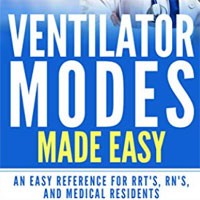Tag: intubation
Postintubation Sedation Administration in the Pediatric ED
Most pediatric patients do not receive PIS within an adequate time frame. Patients who receive long-acting paralytic agents are much less likely to be adequately sedated after rapid sequence intubation (RSI) compared with... read more
Estimated and Measured Post-tetanic Count Effect
Comparison of two pharmacokinetic–pharmacodynamic models of rocuronium bromide during profound neuromuscular block. Our findings indicate that using plasma concentrations of rocuronium bromide estimated with either of... read more
Physiologically Difficult Airway Evaluation
Multiple international airway societies have created guidelines for the management of the difficult airway. In critically ill patients, there are physiologic derangements beyond inadequate airway protection or hypoxemia.... read more
Liberation from Invasive Mechanical Ventilation with Continued Receipt of Vasopressor Infusions
Weaning protocols for discontinuation of invasive mechanical ventilation often mandate resolution of shock. Whether extubation while receiving vasopressors is associated with harm is uncertain. To examine whether extubation... read more
Treating Hypoxia in Discharged COVID-19 Patients
The ICU technique of placing a hypoxic patient in a prone position is being widely used to care for COVID-19 patients in respiratory distress to improve oxygenation and possibly to avoid intubation. The COVID-19 pandemic... read more
Noninvasive Respiratory Support for COVID-19 Patients: When, for Whom, and How?
The significant mortality rate and prolonged ventilator days associated with invasive mechanical ventilation (IMV) in patients with severe COVID-19 have incited a debate surrounding the use of noninvasive respiratory support... read more
Transtracheal Jet Ventilation in the Can’t Intubate Can’t Oxygenate Emergency
Transtracheal jet ventilation (TTJV) is associated with a high risk of device failure and barotrauma in the CICO emergency. Guidelines and recommendations supporting the use of TTJV in CICO should be reconsidered. 44 studies... read more
Retrospective Analysis of Chest X-ray Severity Scoring System of COVID-19 Pneumonia
The research will be retrospective, and will include a review of medical history of all patients admitted in the COVID-19 ICU of the University hospital Osijek during 2020 and 2021. Associated comorbidity, hospital admission... read more
Effect of High-Flow Oxygen Therapy vs Conventional Oxygen Therapy on Invasive Mechanical Ventilation and Clinical Recovery in Patients With Severe COVID-19
An overall good trial that supports the use of high flow oxygen therapy in patients with Severe COVID-19. Randomized controlled trial conducted across three centers in Columbia over 5 months from August 2020 to January... read more
Ventilator Modes Made Easy: An Easy Reference for RRT’s, RN’s, and Medical Residents
Who says understanding ventilator modes has to be hard? This book gives you easy to understand information that every RRT, RN, or Resident always wishes they had. Each mode is described in simple language and answers the... read more

Respiratory Drive in Sepsis and Septic Shock Patients: Modulation by High-flow Nasal Cannula
Patients with sepsis and septic shock of extrapulmonary origin present elevated respiratory drive and effort, which can be effectively reduced by high-flow nasal cannula. 25 nonintubated patients with extrapulmonary sepsis... read more
Mechanical Ventilation Promotes Lung Tumor Spread by Modulation of Cholesterol Cell Content
Mechanical stretch of cancer cells can alter their invasiveness. During mechanical ventilation, lungs may be exposed to an increased amount of stretch, but the consequences on lung tumors have not been explored. To characterize... read more
Safe Tracheal Extubation After General Anesthesia
Tracheal extubation generates less interest than tracheal intubation. Research, guidelines and clinical anecdotes tend to focus on airway management at the beginning of anesthesia, and it is rare for the challenges of extubation... read more
Intubation Practice and Outcomes Among Pediatric Emergency Departments
While tracheal intubation (TI) characteristics vary between pediatric Emergency Departments and ICUs, outcomes are similar. Shock and limited mouth opening were independently associated with adverse TI events in the Emergency... read more
Etomidate vs. Ketamine for Emergency Endotracheal Intubation
While the primary outcome of Day 7 survival was greater in patients randomized to ketamine, there was no significant difference in survival by Day 28. A prospective, randomized, open-label, parallel assignment, single-center... read more
Outcome After Intubation for Septic Shock with Respiratory Distress and Hemodynamic Compromise
Intubation within 24 h of sepsis was not associated with hospital mortality but resulted in fewer 28-day hospital-free days. Although intubation remains a high-risk procedure, we did not identify an increased risk in mortality... read more
To Bronch or Not to Bronch – That Is the Question
Percutaneous tracheostomy was safely and effectively performed by an experienced surgical team both with and without bronchoscopic guidance with no difference in the complication rates. This study suggests that the use... read more
First-Pass Orotracheal Intubation: Video Laryngoscopy vs. Direct Laryngoscopy
Among patients in the ICU requiring intubation, video laryngoscopy compared with direct laryngoscopy did not improve first-pass orotracheal intubation rates and was associated with higher rates of severe life-threatening... read more
Facemask vs. Helmet – Noninvasive Ventilation
We use Noninvasive ventilation (NIV) to treat various disease processes, such as acute hypercapnic and hypoxemic respiratory failure, post-extubation failure, and neuromuscular diseases. Data supports NIV use in some conditions,... read more
Head Rotation in Anaesthetised Apnoeic Patients Significantly Increases Mask Ventilation Efficiency
Head rotation of 45° in anaesthetised apnoeic adults significantly increases the efficiency of mask ventilation compared with the neutral head position. Head rotation is an effective alternative to improve mask ventilation... read more
Mechanically Ventilated COVID-19 Patients: Long-term Survival Study
The long-term survival of mechanically ventilated patients with severe COVID-19 reaches more than 50% and may help to provide individualized risk stratification and potential treatments. 868 patients were included (median... read more
ARDS vs. PseudoARDS – Failure of the Berlin Definition
True ARDS might be defined as a histological diagnosis involving diffuse alveolar damage throughout the lungs (characterized by hyaline membrane formation and thickening of the alveolar walls). PseudoARDS refers to patients... read more









